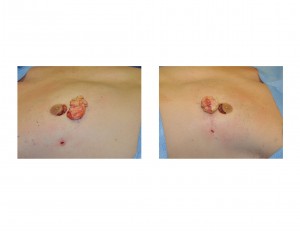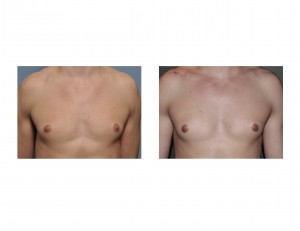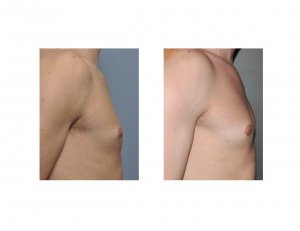Background: Gynecomastia is historically perceived as being the development of breast tissue in men that creates the appearance of an actual breast mound. While this is certainly true, gynecomastia takes on many forms based on the amount of breast tissue development that actually occurs. Gynecomastia presentations can occur along a spectrum from a full blown development of a breast mound to just a firm nodule under the nipple in the teenager and younger man.
Over the years the young men that appear for the surgical treatment of gynecomastia has changed. While very obvious breast enlargements, either one one side or both sides, used to be the norm, smaller types of gynecomastia now appear. Years go they would have been deferred from surgery as their gynecomastia was not deemed significant enough to warrant the risks of surgery.
But contemporary younger male physiques have a standard of a completely flat chest with no nipple-areolar protrusion. Any amount of chest mound prominence or nipple-areolar elevation is viewed as undesireable. It is embarrassing for young men, or men of any age for that matter, to have nipples that show through their shirt or chest mounds that jiggle as they run or exercise. (or even walk) A flat chest profile prevents these aesthetic and clothing problems, avoids embarrassment and potential ridicule and improve’s a young man’s self-esteem.
Case Study: This 21 year-old make college student wanted to improve the shape of his chest. While he was athletic and muscular, he felt his nipples were ‘puffy’ and stuck out too far. He could feel a small lump under his nipples and wanted it removed to flatten them. Given the size and location of these chest lumps, this type of breast enlargement can be an areolar gynecomastia.



Case Highlights:
1) Puffiness of the nipple, most commonly seen in younger men, is caused by a small amount of underlying gynecomastia.
2) Puffy nipple gynecomastia does not respond very well to liposuction due to the firmness of the breast tissue.
3) Open excision of the breast tissue causing the protruding male nipple is the most effective approach to getting a flat areolar and nipple profile.
Dr. Barry Eppley
Indianapolis, Indiana


